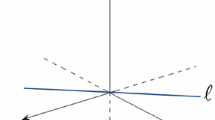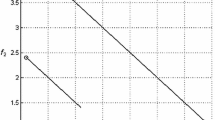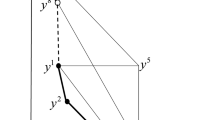Abstract
Optimizing over the efficient set of a multi-objective optimization problem is among the difficult problems in global optimization because of its nonconvexity, even in the linear case. In this paper, we consider only properly efficient solutions which are characterized through weighted sum scalarization. We propose a numerical method to tackle this problem when the objective functions and the feasible set of the multi-objective optimization problem are convex. This algorithm penalizes progressively iterates that are not properly efficient and uses a sequence of convex nonlinear subproblems that can be solved efficiently. The proposed algorithm is shown to perform well on a set of standard problems from the literature, as it allows to obtain optimal solutions in all cases.





Similar content being viewed by others
Notes
In particular, we have observed this situation for problem \(P_9\) when \(\beta \ge 100\). The reason is that \(\gamma \) increases too fast hence \(\phi (x)\) is not given enough importance in the objective function.
References
Alves, M. J., & Costa, J. P. (2009). An exact method for computing the nadir values in multiple objective linear programming. European Journal of Operational Research, 198, 637–646.
Ankhili, Z., & Mansouri, A. (2009). An exact penalty on bilevel programs with linear vector optimization lower level. European Journal of Operational Research, 197, 36–41.
Belousov, E., & Klatte, D. (2002). A Frank–Wolfe type theorem for convex polynomial programs. Computational Optimization and Applications, 22, 37–48.
Benson, H. P. (1984). Optimization over the efficient set. Journal of Mathematical Analysis and Applications, 98, 562–580.
Benson, H. P. (1986). An algorithm for optimizing over the weakly-efficient set. European Journal of Operational Research, 25, 192–199.
Benson, H. P. (1990). An all-linear programming relaxation algorithm for optimizing over the efficient set. Journal of Global Optimization, 1, 83–104.
Benson, H. P. (1992). A finite, nonadjacent extreme-point search algorithm for optimization over the efficient set. Journal of Optimization Theory and Applications, 73, 47–64.
Benson, H. P. (1993). A bisection-extreme point search algorithm for optimizing over the efficient set in the linear dependence case. Journal of Global Optimization, 3, 95–111.
Benson, H. P. (2012). An outcome space algorithm for optimization over the weakly efficient set of a multiple objective nonlinear programming problem. Journal of Global Optimization, 52, 553–574.
Benson, H. P., & Lee, D. (1996). Outcome-based algorithm for optimizing over the efficient set of a bicriteria linear programming problem. Journal of Optimization Theory and Applications, 88, 77–105.
Bolintinéanu, S. (1993). Minimization of a quasi-concave function over an efficient set. Mathematical Programming, 61, 89–110.
Bolintinéanu, S., & El Maghri, M. (1997). Pénalisation dans l’optimisation sur l’ensemble faiblement efficient. RAIRO Recherche opérationnelle, 31, 295–310.
Bonnel, H., & Morgan, J. (2006). Semivectorial bilevel optimization problem: Penalty approach. Journal of Optimization Theory and Applications, 131, 365–382.
Calvete, H. I., & Galé, C. (2011). On linear bilevel problems with multiple objectives at the lower level. Omega, 39, 33–40.
Chinchuluun, A., & Pardalos, P. M. (2007). A survey of recent developments in multiobjective optimization. Annals of Operations Research, 154(1), 29–50.
Dauer, J. P. (1991). Optimization over the efficient set using an active constraint approach. Mathematical Methods of Operations Research, 35, 185–195.
Deb, K., Miettinen, K., & Chaudhuri, S. (2010). Toward an estimation of nadir objective vector using a hybrid of evolutionary and local search approaches. IEEE Transactions on Evolutionary Computation, 14, 821–841.
Dessouky, M., Ghiassi, M., & Davis, W.J. (1979). Determining the worst value of an objective function within the nondominated solutions in multiple objective linear programming, working Paper, Department of Mechanical and Industrial Engineering, University of Illinois, Urbana, Illinois.
Dessouky, M. I., Ghiassi, M., & Davis, W. J. (1986). Estimates of the minimum nondominated criterion values in multiple-criteria decision-making. Engineering Costs and Production Economics, 10, 95–104.
Ecker, J. G., & Song, J. H. (1994). Optimizing a linear function over an efficient set. Journal of Optimization Theory and Applications, 83, 541–563.
Ehrgott, M. (2005). Multicriteria optimization. Berlin: Springer.
Geoffrion, A. M. (1968). Proper efficiency and the theory of vector maximization. Journal of Mathematical Analysis and Applications, 22(3), 618–630.
Geromel, J. C., & Ferreira, P. A. V. (1991). An upper bound on properly efficient solutions in multiobjective optimization. Operations Research Letters, 10, 83–86.
Grant, M., & Boyd, S. (2008). Graph implementations for nonsmooth convex programs. In Recent advances in learning and control (pp. 95–110).
Grant, M.C., & Boyd, S.P. (2017). CVX: Matlab software for disciplined convex programming. http://cvxr.com/cvx.
Hamel, A. H., Löhne, A., & Rudloff, B. (2014). Benson type algorithms for linear vector optimization and applications. Journal of Global Optimization, 59(4), 811–836.
Horst, R., & Thoai, N. V. (1999). Maximizing a concave function over the efficient or weakly-efficient set. European Journal of Operational Research, 117, 239–252.
Isermann, H., & Steuer, R. E. (1987). Computational experience concrning payoff tables and minimum criterion values over the efficient set. European Journal of Operational Research, 33, 91–97.
Jorge, J. M. (2005). A bilinear algorithm for optimizing a linear function over the efficient set of a multiple objective linear programming problem. Journal of Global Optimization, 31, 1–16.
Karimi, M., & Karimi, B. (2017). Linear and conic scalarizations for obtaining properly efficient solutions in multiobjective optimization. Mathematical Sciences, 11(4), 319–325.
Konno, H., & Inori, M. (1989). Bond portfolio optimization by bilinear fractional programming. Journal of the Operations Research Society of Japan, 32, 143–158.
Konno, H., Thach, P. T., & Tuy, H. (1997). Optimization on low rank nonconvex structures. Boston: Springer.
Korhonen, P., & Wallenius, J. (1989). A careful look at efficiency and utility in multiple criteria decision making: A tutorial. Asia-Pacific Journal of Operational Research, 6(1), 46–62.
Kuhn, H.W., & Tucker, A.W. (1951). Nonlinear programming. In Proceedings of the second Berkeley symposium on mathematical statistics and probability (pp. 481–492). University of California Press, Berkeley and Los Angeles.
Liu, Z., & Ehrgott, M. (2018). Primal and dual algorithms for optimization over the efficient set. Optimization, 67(10), 1661–1686.
Luc, D. T. (1989). Theory of vector optimization. Berlin: Springer.
Luc, L. T. (2001). Reverse polyblock approximation for optimization over the weakly efficient set and efficient set. Acta Mathematica Vietnamica, 26, 65–80.
Miettinen, K. (1999). Nonlinear multiobjective optimization. Boston: Kluwer Academic Publishers.
Muu, L. D. (2000). A convex-concave programming method for optimizing over the efficient set. Acta Mathematica Vietnamica, 25, 67–85.
Nocedal, J., & Wright, S. (1999). Numerical optimization. New York: Springer.
Ogryczak, W. (2000). Multiple criteria linear programming model for portfolio selection. Annals of Operations Research, 97(1), 143–162.
Phillip, J. (1972). Algorithms for the vector maximization problem. Mathematical Programming, 2, 207–229.
Reeves, G. R., & Reid, R. C. (1988). Minimum values over the efficient set in multiple objective decision making. European Journal of Operational Research, 36, 334–338.
Ren, A., & Wang, Y. (2016). A novel penalty function method for semivectorial bilevel programming problem. Applied Mathematical Modelling, 40, 135–149.
Sayin, S. (2000). Optimizing over the efficient set using a top-down search of faces. Operations Research, 48, 65–72.
Shigeno, M., Takahashi, I., & Yamamoto, Y. (2003). Minimum maximal flow problem: An optimization over the efficient set. Journal of Global Optimization, 25, 425–443.
Steuer, R. E. (1986). Multiple criteria optimization: Theory, computation, and applications. New York: Wiley.
Steuer, R. E., Qi, Y., & Hirschberger, M. (2007). Suitable-portfolio investors, nondominated frontier sensitivity, and the effect of multiple objectives on standard portfolio selection. Annals of Operations Research, 152(1), 297–317.
Thach, P. T., & Thang, T. V. (2014). Problems with resource allocation constraints and optimization over the efficient set. Journal of Global Optimization, 58, 481–495.
Thach, P. T., Konno, H., & Yokota, D. (1996). Dual approach to minimization on the set of pareto-optimal solutions. Journal of optimization theory and applications, 88, 689–707.
Thoai, N. V. (2000a). A class of optimization problems over the efficient set of a multiple criteria nonlinear programming problem. European Journal of Operational Research, 122, 58–68.
Thoai, N. V. (2000b). Conical algorithm in global optimization for optimizing over efficient sets. Journal of Global Optimization, 18, 321–336.
Toh, K. C., Todd, M., & Tütüncü, R. (1999). SDPT3–A MATLAB software package for semidefinite programming, version 1.3. Optimization Methods and Software, 11(1–4), 545–581.
Tütüncü, R., Toh, K., & Todd, M. (2003). Solving semidefinite-quadratic-linear programs using SDPT3. Math Program, 95(2), 189–217.
Tuy, H., & Hoai-Phuong, N. T. (2006). Optimization under composite monotonic constraints and constrained optimization over the efficient set. In L. Liberti & N. Maculan (Eds.), Global optimization: From theory to implementation (pp. 3–31)., Nonconvex optimization and its applications New York: Springer.
Tuyen, H. Q., & Muu, L. D. (2001). Biconvex programming approach to optimization over the weakly efficient set of a multiple objective affine fractional problem. Operations Research Letters, 28, 81–92.
Wang, H., He, S., & Yao, X. (2015). Nadir point estimation for many-objective optimization problems based on emphasized critical regions. Methodologies and Application, 21, 2283–2295.
White, D. J. (1996). The maximization of a function over the efficient set via a penalty function approach. European Journal of Operational Research, 94, 143–153.
Wierzbicki, A. P. (1980). The use of reference objectives in multiobjective optimization. In Multiple criteria decision making theory and application (pp. 468–486). Berlin, Heidelberg, Lecture Notes in Economics and Mathematical Systems: Springer.
Yamada, S., Tanino, T., & Inuiguchi, M. (2000). An inner approximation method for optimization over the weakly efficient set. Journal of Global Optimization, 16, 197–217.
Yamada, S., Tanino, T., & Inuiguchi, M. (2001). An inner approximation method incorporating a branch and bound procedure for optimization over the weakly efficient set. European Journal of Operational Research, 133, 267–286.
Yamamoto, Y. (2003). Optimization over the efficient set: overview. Journal of Global Optimization, 22, 285–317.
Zheng, Y., & Wan, Z. (2011). A solution method for semivectorial bilevel programming problem via penalty method. Journal of Applied Mathematics and Computing, 37, 207–219.
Acknowledgements
The first and third authors acknowledge the support of the Direction Générale de la Recherche Scientifique et du Développement Technologique (DGRSDT) Grant ID: C0656104. We are grateful to the reviewer whose comments allowed us to improve the manuscript significantly.
Author information
Authors and Affiliations
Corresponding author
Additional information
Publisher's Note
Springer Nature remains neutral with regard to jurisdictional claims in published maps and institutional affiliations.
Rights and permissions
About this article
Cite this article
Ghazli, K., Gillis, N. & Moulaï, M. Optimizing over the properly efficient set of convex multi-objective optimization problems. Ann Oper Res 295, 575–604 (2020). https://doi.org/10.1007/s10479-020-03820-4
Accepted:
Published:
Issue Date:
DOI: https://doi.org/10.1007/s10479-020-03820-4




